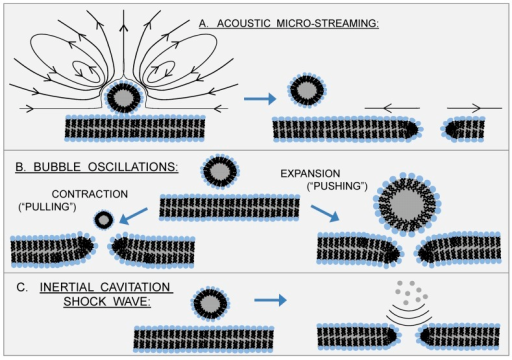Sonoporation, or cellular sonication, is the use of sound (typically ultrasonic frequencies) for modifying the permeability of the cell plasma membrane. This technique is usually used in molecular biology and non-viral gene therapy in order to allow uptake of large molecules such as DNA into the cell, in a cell disruption process called transfection or transformation. Sonoporation employs the acoustic cavitation of microbubbles to enhance delivery of these large molecules.
The bioactivity of this technique is similar to, and in some cases found superior to, electroporation. Extended exposure to low-frequency (<MHz) ultrasound has been demonstrated to result in complete cellular death (rupturing), thus cellular viability must also be accounted for when employing this technique.
Sonoporation is under active study for the introduction of foreign genes in tissue culture cells, especially mammalian cells. Sonoporation is also being studied for use in targeted Gene therapy in vivo, in a medical treatment scenario whereby a patient is given modified DNA, and an ultrasonic transducer might target this modified DNA into specific regions of the patient’s body.

Genes can be transferred using viral or non-viral vectors. Non-viral methods that use plasmid DNA and short interference RNA (siRNA) have advantages, such as low immunogenicity and low likelihood of genomic integration in the host, when compared to viral methods. Non-viral methods have potential merit, but their gene transfer efficiency is not satisfactory.
Therefore, new methods should be developed. Low-frequency ultrasound irradiation causes mechanical perturbation of the cell membrane, allowing the uptake of large molecules in the vicinity of the cavitation bubbles. The collapse of these bubbles generates small transient holes in the cell membrane and induces transient membrane permeabilization.
This formation of small pores in the cell membrane using ultrasound allows the transfer of DNA/RNA into the cell. This phenomenon is known as sonoporation and is a gene delivery method that shows great promise as a potential new approach in gene therapy. Microbubbles lower the threshold of cavity formation. Complexes of therapeutic genes and microbubbles improve the transfer efficiency of genes. Diagnostic ultrasound is potentially a suitable sonoporator because it allows the real-time monitoring of irradiated fields.
Ultrasound causes cavitation bubbles to form cell membrane pores through which DNA/RNA are transferred. This phenomenon is known as sonoporation. Microbubbles lower the threshold of cavity formation. Sonoporation is less toxic and not associated with tumorigenicity as compared with retroviral and adenoviral vectors. Sonoporation does not require surgical procedure and enhances gene transfer with lipofection. Current limitations of sonoporation are low efficiency of gene transfer and damage of target cells are The use of complexes with chemicals and diagnostic ultrasound are promising approaches to overcome these limitations.
Credit :
Bang ScienceMagazine (youtube video)
Microbubbles and Drug Delivery – Dr Eleanor Stride
National Institute Of Health
